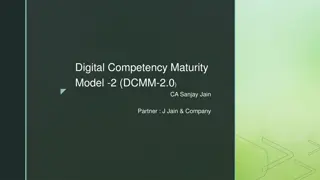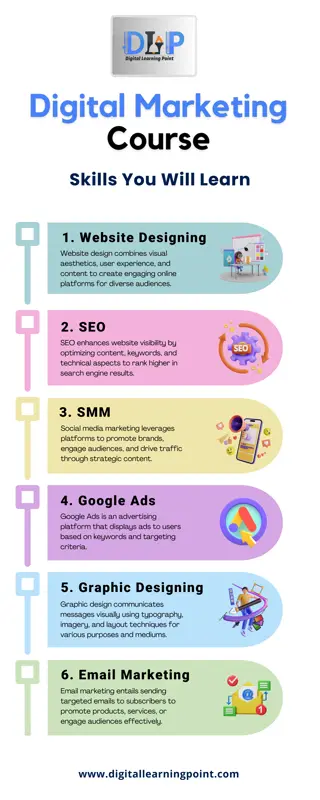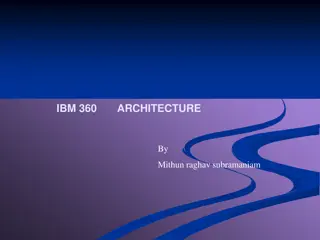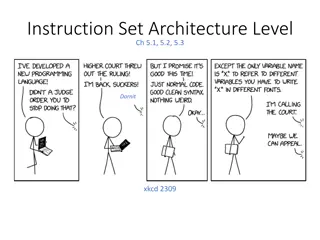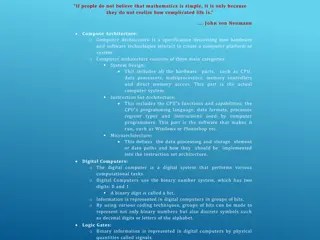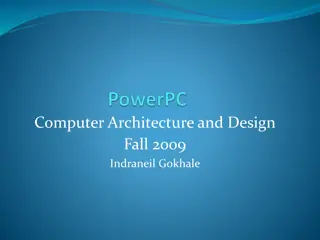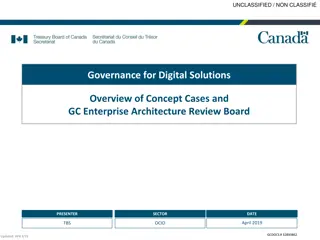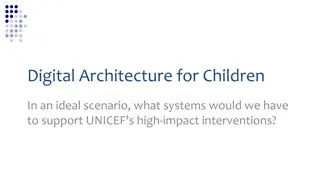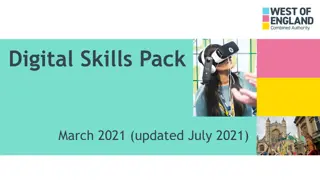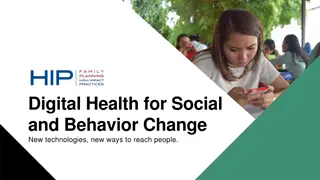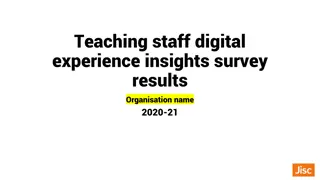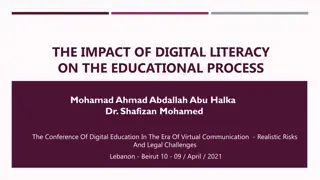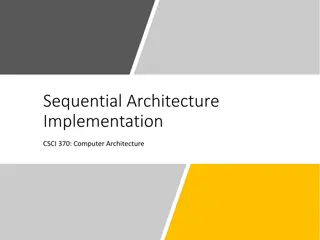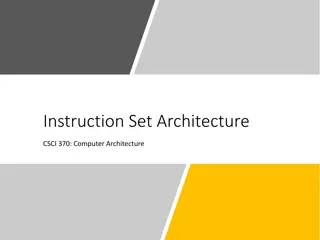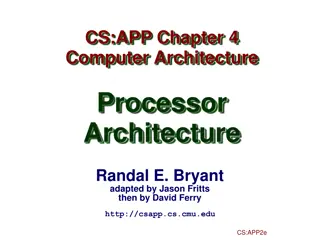for architecture. Digital technologies set in abeyance
Digital technologies, akin to architectural essentials like iron and steel girders, have reshaped educational landscapes, removing longstanding constraints. The rise of online learning and the shift towards digital affordances mark a significant transformation in the field of education. Leveraging the Community of Inquiry framework and embracing a social constructivist perspective, educators are exploring ways to design online learning experiences that combine digital capabilities with the essence of traditional liberal education.
Download Presentation

Please find below an Image/Link to download the presentation.
The content on the website is provided AS IS for your information and personal use only. It may not be sold, licensed, or shared on other websites without obtaining consent from the author.If you encounter any issues during the download, it is possible that the publisher has removed the file from their server.
You are allowed to download the files provided on this website for personal or commercial use, subject to the condition that they are used lawfully. All files are the property of their respective owners.
The content on the website is provided AS IS for your information and personal use only. It may not be sold, licensed, or shared on other websites without obtaining consent from the author.
E N D
Presentation Transcript
D I G I T A L Digital technologies are for education as iron and steel girders, reinforced concrete, plate glass, elevators, central heating and air conditioning were for architecture. Digital technologies set in abeyance significant, long lasting limits on educational activity. --R. O. McClintock,1999 A F F O R D A N C E S Access to Information Multimedia Integration Digital Tools to Augment Intelligence Collaboration
The Community of Inquiry Framework: Building Learning Communities Online Karen Swan University of Illinois Springfield
Students taking at least 1 online course as a % of total enrollments 25,000,000 20,000,000 students 15,000,000 10,000,000 34% 32% 29% 5,000,000 27% 24% 22% 20% 18% 13% 12% 10% 0 Fall 2002 Fall 2003 Fall 2004 Fall 2005 Fall 2006 Fall 2007 Fall 2008 Fall 2009 Fall 2010 Fall 2011 Fall 2012 onground only 15,008,740 14,940,084 14,942,260 14,307,431 14,270,491 14,310,022 14,496,458 14,848,689 14,873,846 14,538,294 14,126,537 1+ online course(s) 1,602,970 1,971,397 2,329,783 3,180,050 3,488,381 3,938,111 4,606,353 5,579,022 6,142,280 6,714,792 7,126,549 (Allen & Seaman, 2013)
So how can we design and implement online learning to take advantage of digital affordances but to still preserve the best aspects of a traditional liberal education?
Community of Inquiry Framework a process model of learning in online and blended educational environments grounded in a social constructivist view of higher education assumes effective learning in higher education requires the development of a community of learners that supports meaningful inquiry
Deliberation (Applicability) Reflection EXPLORATION EXPLORATION INTEGRATION INTEGRATION Perception (Awareness) Conception (Ideas) EXPERIENCE RESOLUTION RESOLUTION TRIGGERING EVENT TRIGGERING EVENT Action (Practice) Discourse practical inquiry model (Garrison, Anderson & Archer, 2000)
C O M M U N I T Y SOCIAL PRESENCE SOCIAL PRESENCE COGNITIVE PRESENCE COGNITIVE PRESENCE LEARNING O F I N Q U I R Y TEACHING PRESENCE TEACHING PRESENCE
SOCIAL PRESENCE SOCIAL PRESENCE the ability of participants in a virtual community project themselves socially and emotionally; their ability to perceive one another as real people; affective expression, cohesion, interactivity
research findings social presence positively related to: student satisfaction perceived & actual learning retention & progression course design but: interesting differences in social presence perceptions among students Interesting differences in effects between students & instructors
some practical implications Develop initial course activities to encourage the development of swift trust. Make participation in discussion a significant part of course grades. Require students to incorporate materials from the discussions in their assignments. Use short videos of yourself to introduce the course and particular topics. Journal or otherwise interact with your students on an individual and personal basis. Use audio to embed feedback on assignments within them. Design community building activities.
COGNITIVE PRESENCE COGNITIVE PRESENCE the extent to which learners are able to construct and confirm meaning through sustained reflection and discourse triggering event, exploration, integration, resolution
Deliberation (Applicability) Reflection EXPLORATION EXPLORATION INTEGRATION INTEGRATION Perception (Awareness) Conception (Ideas) EXPERIENCE RESOLUTION RESOLUTION TRIGGERING EVENT TRIGGERING EVENT Action (Practice) Discourse practical inquiry model(Garrison, Anderson & Archer, 2000)
research findings cognitive presence difficult to move to resolution: most online discussion never moves beyond the exploration stage but: online discussion proceeds to integration & resolution when participants are tasked with problem solution & explicit direction & facilitation are provided & it may be that resolution in some subject areas is individual and happens outside discussion
some practical implications Model, support & encourage diverse points of view in online discussion. Use content & process scaffolds to support discourse behaviors. Use online discussion & writing activities to support conceptual learning and divergent thinking. Use self-testing, practice assignments, simulations & other interactive activities to support skill development & convergent thinking. Develop grading rubrics for discussion & course activities that reward desired cognitive behaviors. Provide frequent opportunities for testing & feedback.
the design, facilitation and direction of cognitive and social processes for the purpose of realizing educationally worthwhile learning outcomes TEACHING PRESENCE TEACHING PRESENCE design & organization, facilitation, direct instruction
social presence .52 (.52)** .52 (.49)** teaching presence teaching presence cognitive presence .49(.47)** (Shea & Bidjermo, 2009)
research findings teaching presence positively related to: development of social & cognitive presence satisfaction & learning development of a sense of community in online courses and: critically important to successful online learning
some practical implications Provide frequent opportunities for both public and private interactions with students. Provide students with timely & supportive feedback. Apply collaborative learning principles to support small group discussion and collaborative projects. Design diverse activities to be completed every week. Design courses for learner choice, flexibility & control. Design and review courses for clarity & consistency.
Community of Inquiry Survey 34 five-point Likert-type items with which respondents indicate agreement/disagreement 13 teaching presence, 9 social presence, 12 cognitive presence items, including at least 3 for each element of each presence validated by factor analysis of data obtained from multiple institutions used as a measure of student perceptions of learning processes around the world for both research & practical purposes
practical implications -- course redesignQM design based research involving the redesign of core courses in a graduate program in Teacher Leadership based on the Quality Matters rubric, followed by the iterative tweaking of course design and implementation to addressed low-scoring items on the CoI survey
QM research questions Can course redesign based on meeting Quality Matters standards (QM revisions) result in improved student learning outcomes? Can changes in course design and implementation targeted to enhance particular Community of Inquiry scores (CoI revisions) lead to both increased CoI scores and improved learning outcomes? What is the effect of the two-phased combination of QM revisions & CoI revisions on student learning outcomes?
QM methodology subjects graduate students enrolled in EDL core courses (105/135 = 76% response rate) instruments QM review & CoI survey outcome measures standardized scores (percent correct) on major course assignments and overall course grades data analysis descriptive, ANOVA
initial QM revision & iterative CoI tweaking collect CoI survey & outcomes data QM review & revisions collect CoI survey & outcomes data baseline post QM CoI analysis & revisions collect CoI survey & outcomes data CoI 1 CoI analysis & revisions CoI 2 collect CoI survey & outcomes data CoI analysis & revisions CoI 3 collect CoI survey & outcomes data
QM course redesign: results Outcomes significantly improved in three out of four of the core courses involved. Educational Research outcomes scores 100.0 outcomes in percent correct 95.0 90.0 85.0 80.0 75.0 ** 70.0 ** * RPROP FINALX GRADE FA09 86.7 75.3 93.8 SP10 96.9 87.8 93.8 SU10 95.8 85.2 94.8 FA10 97.2 90.1 98.1 SP11 97.7 90.3 96.1
Curriculum & Assessment outcomes scores 100.0 outcomes in percent correct 95.0 90.0 85.0 80.0 75.0 ** P1 ** ** 70.0 P2 GRADE SP11 93.9 97.1 96.7 FA11 96.0 97.5 96.8 SP12 99.3 99.3 98.8 SU12 99.5 100.0 99.5 Teacher Leadership outcome scores 100.00 outcomes in percent correct 95.00 90.00 85.00 80.00 75.00 70.00 * P1 P2 REFLECT GRADE SP11 95.82 91.60 98.04 96.16 FA11 97.63 97.56 99.77 99.04 SP12 97.19 97.82 100.00 98.36 FA12 94.55 98.92 96.92 97.92
The Community of Inquiry model provides a meaningful framework for developing, implementing, & exploring online learning. It helps us to build learning communities online. But it is just a start we also need to rethink teaching and learning, not just for the online environment, but also for the digital age
R E T H I N K I N G T E A C H I N G Rethinking Pedagogy Conducting Learning Rethinking Boundaries Learning While Mobile Rethinking Curricula What Knowledge Is Most Important
R E T H I N K I N G L E A R N I N G Rethinking Engagement Rethinking Individualization & Choice Rethinking Collaboration Rethinking Learning for All





